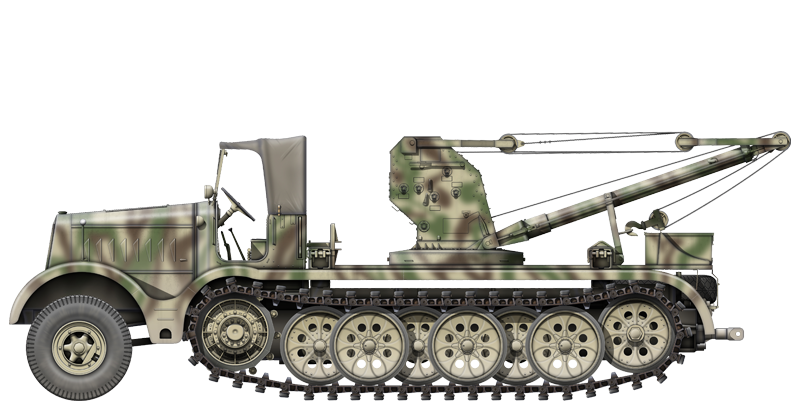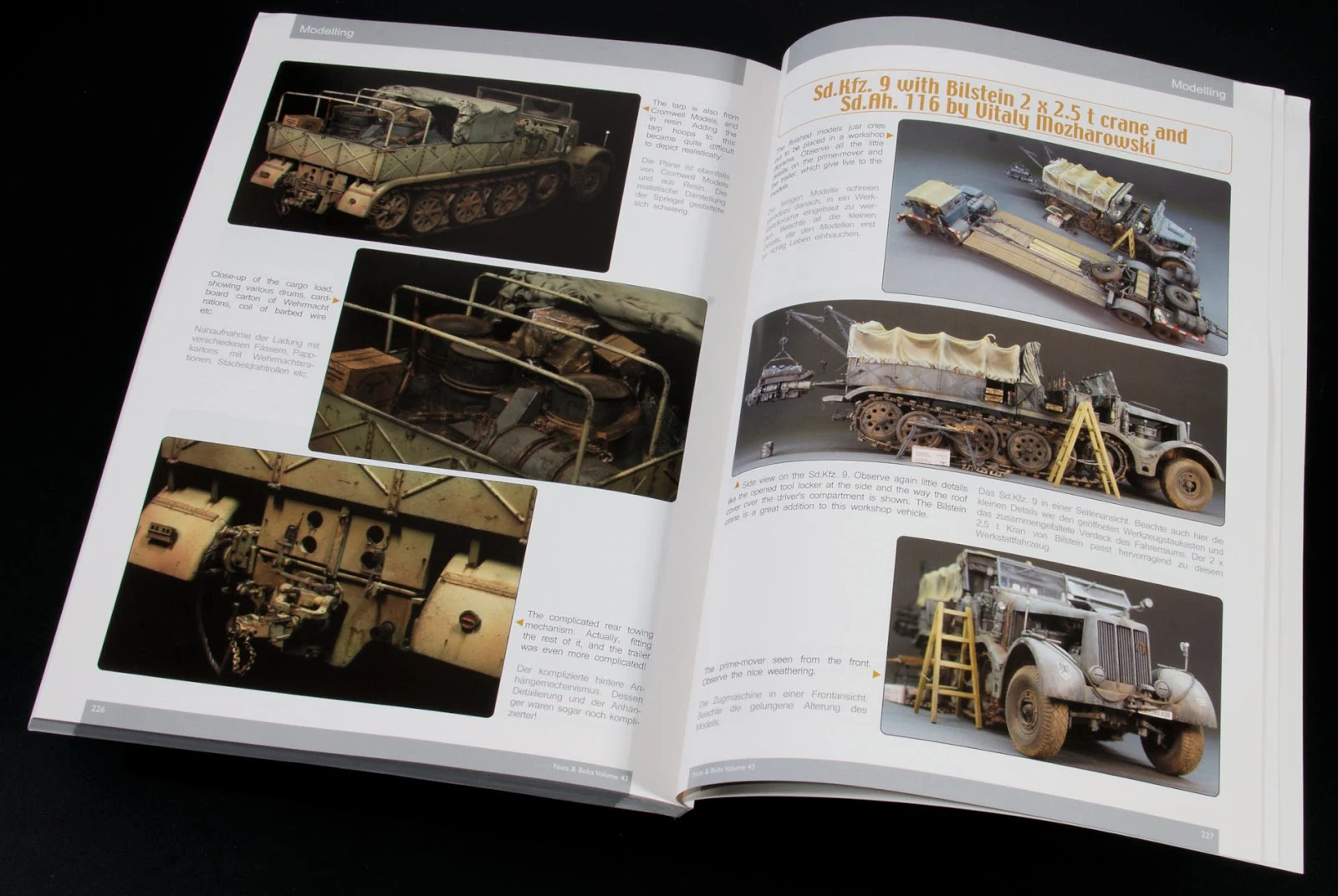Paul has been waiting for this - Nuts & Bolts latest book in their series that featured the heavy workforce of the german armed forces, the Famo Sd.Kfz9 18tonner and its variants. See what he thought of the book and what is inside in his review...
Read n' Reviewed: Nuts & Bolts vol 43: Famo’s Sd.Kfz.9 18 ton Zugkraftwagen armoured and unarmoured variants
Authors: Heiner F Duske, Tony Greenland, Detlev Terlisten
Softcover 232 Pages Softcover A4 Portrait
English and German text
Available from www.nuts-bolts.de
The Sd.Kfz 9 Famo needs no introduction to armour modellers with numerous kits available by various manufacturers in both 1/35 and 1/72 scale, although the name Famo is actually the name of the manufacturer, and not the name of the vehicle. The Sd.Kfz 9 served in a variety of roles, but probably most well known for being a tank transporter when towing the Sd.Ah 116 trailer courtesy of Tamiya, and also mounted the infamous 88mm Flak as a mobile anti-aircraft gun.
The REALLY avid followers/collectors of the Nuts & Bolts series might recall that this vehicle has been done before, and the book points out that the Sd.Kfz 9 was first covered in 1999, and that the authors and editors decided to revisit this vehicle due to the amount of information that has become available since then. And this is definitely not just a re-release of the old edition with a few extra pages since the back cover illustrates the original edition as volume 12 with 98 pages, compared to this volume with 232, which makes me think that there is definitely new information that has emerged since 1999!
As always, the book starts with the development of the vehicle, which arose from the need to tow the 240mm K3 Kanone, and the 355mm M1 Morser. The text covers the various elements of the vehicle from the engine, to the tracks, road wheels, suspension, basically the entire vehicle so you get a very comprehensive picture of how the vehicle was developed.
With the large artillery pieces such as the 240mm K3, and 355mm M1 that the Sd.Kfz was tasked with towing, there is a new section on Operation and Experience reports which is self-explanatory, and also accompanied by charts illustrating how they were deployed within their units. The size of the aforementioned artillery pieces meant that they needed to be taken apart before they could be towed and there are a good number of photos showing this.
There is an enlarged section on photos of the vehicle and you get many of good high quality shots of the Famo in action, and one thing that becomes apparent with the pictures is how big this tractor actually is. There is a nice contrast between the playfulness of the top image of a group of children posing on the tractor, and then the “serious” looking one in the picture below. I must say the picture of the children would definitely make for a good vignette.
There are quite of few characteristic shots of the Famo on its haunches with its front wheels in the air, and many pictures of the Famo in its various roles towing artillery pieces, tractor, tank transporter, tank recovery vehicle and mounting the 88mm in both armoured and unarmoured versions.
There is even a section on the Famo in post-war use, which is something that we often forget about wartime vehicles, and the towing capacity of the Famo is definitely an ability that would be useful even in civilian use.
The following section features line drawings of some of the various uses of the Famo including the basic transport, mounted with a crane or the 88mm gun. Line drawings of the Sd.Ah 116 trailer are also included so they really don’t skimp on the information provided in the book.
There is a nice selection of colour profiles which are interpretations of some of the photos included in the book which is a nice touch because there are times where you do question artist interpretations so having the photo beside the profile is very handy.
The walkaround section gives us a walkaround of the various surviving examples of the Famo. There is a range of vehicles from those in running condition, to various junkyard states, more inspiration for if you want to build your one differently to everyone else.
From the walkaround of the exterior of the vehicle, we are given a wide variety of the different components of the vehicle such as the chassis, driver’s cabin, wheels etc. Unfortunately, there are no surviving examples of the Famo with an 88mm mounted on the rear so the book gives you some pictures of a surviving 88.
Finallly, we have a selection of models of the various variants in both 1/35 and 1/72 by Tony Greenland, Vinnie Branigan, Vitaly Mozharowski, Peter Zakanyi, and Darren Thompson. I was very impressed by Peter Zakanyi’s post-war example being used in a quarry with a tractor bucket mounted on the front.
While I haven’t seen the original edition, the jump in the number of pages, and the quality of the information and photographs included in this book surely warrant another purchase, even if you do have the original in my opinion, and plenty of inspiration for your next build if the Sd.Kfz is on your mind or in your stash. Another quality publication by Nuts & Bolts and highly recommended as usual.
Paul Lee
Read n' Reviewed: Nuts & Bolts vol 43: Famo’s Sd.Kfz.9 18 ton Zugkraftwagen armoured and unarmoured variants
Authors: Heiner F Duske, Tony Greenland, Detlev Terlisten
Softcover 232 Pages Softcover A4 Portrait
English and German text
Available from www.nuts-bolts.de
The Sd.Kfz 9 Famo needs no introduction to armour modellers with numerous kits available by various manufacturers in both 1/35 and 1/72 scale, although the name Famo is actually the name of the manufacturer, and not the name of the vehicle. The Sd.Kfz 9 served in a variety of roles, but probably most well known for being a tank transporter when towing the Sd.Ah 116 trailer courtesy of Tamiya, and also mounted the infamous 88mm Flak as a mobile anti-aircraft gun.
As always, the book starts with the development of the vehicle, which arose from the need to tow the 240mm K3 Kanone, and the 355mm M1 Morser. The text covers the various elements of the vehicle from the engine, to the tracks, road wheels, suspension, basically the entire vehicle so you get a very comprehensive picture of how the vehicle was developed.
With the large artillery pieces such as the 240mm K3, and 355mm M1 that the Sd.Kfz was tasked with towing, there is a new section on Operation and Experience reports which is self-explanatory, and also accompanied by charts illustrating how they were deployed within their units. The size of the aforementioned artillery pieces meant that they needed to be taken apart before they could be towed and there are a good number of photos showing this.
There is an enlarged section on photos of the vehicle and you get many of good high quality shots of the Famo in action, and one thing that becomes apparent with the pictures is how big this tractor actually is. There is a nice contrast between the playfulness of the top image of a group of children posing on the tractor, and then the “serious” looking one in the picture below. I must say the picture of the children would definitely make for a good vignette.
There are quite of few characteristic shots of the Famo on its haunches with its front wheels in the air, and many pictures of the Famo in its various roles towing artillery pieces, tractor, tank transporter, tank recovery vehicle and mounting the 88mm in both armoured and unarmoured versions.
There is even a section on the Famo in post-war use, which is something that we often forget about wartime vehicles, and the towing capacity of the Famo is definitely an ability that would be useful even in civilian use.
The following section features line drawings of some of the various uses of the Famo including the basic transport, mounted with a crane or the 88mm gun. Line drawings of the Sd.Ah 116 trailer are also included so they really don’t skimp on the information provided in the book.
There is a nice selection of colour profiles which are interpretations of some of the photos included in the book which is a nice touch because there are times where you do question artist interpretations so having the photo beside the profile is very handy.
The walkaround section gives us a walkaround of the various surviving examples of the Famo. There is a range of vehicles from those in running condition, to various junkyard states, more inspiration for if you want to build your one differently to everyone else.
From the walkaround of the exterior of the vehicle, we are given a wide variety of the different components of the vehicle such as the chassis, driver’s cabin, wheels etc. Unfortunately, there are no surviving examples of the Famo with an 88mm mounted on the rear so the book gives you some pictures of a surviving 88.
Finallly, we have a selection of models of the various variants in both 1/35 and 1/72 by Tony Greenland, Vinnie Branigan, Vitaly Mozharowski, Peter Zakanyi, and Darren Thompson. I was very impressed by Peter Zakanyi’s post-war example being used in a quarry with a tractor bucket mounted on the front.
While I haven’t seen the original edition, the jump in the number of pages, and the quality of the information and photographs included in this book surely warrant another purchase, even if you do have the original in my opinion, and plenty of inspiration for your next build if the Sd.Kfz is on your mind or in your stash. Another quality publication by Nuts & Bolts and highly recommended as usual.
Paul Lee
Thanks to Nuts & Bolts for sending this book to read and review.
















